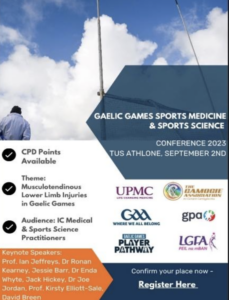Author: Dr. Patrick O’Meara (Twitter – @pad_om) – GP Trainee with a special interest in SEM. Final year MSc Sports and Exercise Medicine Student – University of South Wales.
The inaugural Gaelic Games Sports Medicine and Sports Science Scientific Conference was held in TUS Athlone on the 2nd of September 2023. The theme of the event was Musculotendinous Lower Limb Injuries in Gaelic Games with presentations on a variety of topics delivered by medical, academic, and allied-health keynote speakers. The event was organised by members of the Gaelic Athletic Association’s (GAA) Medical, Scientific and Welfare Committee, GAA’s Physiotherapy and Rehabilitation Group and Gaelic Athletic Medical Association.

Pertinent points that were discussed at the inaugural meeting are synopsised below for the interest of BJSM Blog readers.
Sean Dunnion (Chairperson of MSW committee) and Dr. Eamonn O’Reilly (Chairperson of Physiotherapy and Rehabilitation Group) began proceedings by welcoming attendees and outlining the timetable of events. Speakers emphasised the necessity to develop and expand on the already existing central repository of injuries for senior intercounty players.
Key take home points from conference:
Hamstring Injury Assessment and Diagnosis – Dr. Ronan Kearney
- Injury burden of Hamstring Injury in Gaelic Games is comparable to that seen in elite level soccer.
- BAMIC Classification for hamstring injury aids with stratification of risk of re-injury with type C injuries at highest risk (1).
- Tendon healing physiology differs greatly to muscle healing therefore respect of healing needs to be reflected in return to play decision making (1).
Epidemiology of Lower Limb Injury – Dr. Edna Whyte
- Highlighted the how, what and why of lower limb injury in Gaelic games based on current data available.
- Emphasis placed on the importance of compliance of intercounty medical teams to the new central injury management database.
Diagnosis and Assessment of Calf Injuries – Dr. Joe Jordan
- Emphasis placed on the longer return to play time with associated connective tissue involvement and aponeurosis disruption.
- Ultrasound can play a diagnostic and therapeutic role in calf injury – anatomical assessment of dynamic function and interventional procedures such as drainage of intrafascial hematoma (2).
Female Physiology – Professor Kirsty Elliott-Sale
- The four physiological stages of menstruation were discussed – exploitation of the impact of the benefits to the athlete who has a menstrual period in each phase and mitigation of negative impact of each phase highlighted.
- There is currently insufficient high-quality evidence to support menstrual cycle phase-based training approaches and therefore as practitioners it is vital that we operate on a case by case basis.
Dealing with Long Term Injury – Jessie Barr OLY
- It is important to understand the psychological implications of injury and to identify best practices in how to manage them – i.e. identification and maintenance of athlete motivating factors and confidence building.
- There are good, bad and ugly psychological responses to injury with no common response among athletes. It is vital to be aware that thoughts create emotions, emotions influence behaviour and that behaviour reinforces thought.
Return to Play Post Calf Injury – David Breen MISCP
- Loading in all directions as well as extending power phase of rehabilitation is recommended.
- It is important to be wary of acceleration and deceleration dense training while returning to play.
Rethinking the Journey Back to Gamespeed – Professor Ian Jeffreys
- Provided an alternative perspective on return to play post injury.
- Advocated for a joint physiotherapy and strength a conditioning approach to all stages of rehabilitation of an injury
- The journey to return to play involves establishing positions, patterns, progressing patterns, introducing sports generic and specific scenarios and return to practice.
Hamstring Rehabilitation and Return to Play – Jack Hickey PhD
- Consideration should be given to progressive loading in hamstring injury (3).
- Such early loading can lead to increased biceps femoris long head fascicle length and increase eccentric knee flexor strength (3).
The day’s proceedings concluded with a round table discussion on a Multi-disciplinary Team approach to management of a high-grade hamstring tear in a GAA intercounty player. The discussion was chaired by Dr. Aoife Lane and contributions were delivered through perspectives from Rena Buckley (Player, Cork GAA All-Star Player), Ger Ryan (Administrator, Chairman GAA Munster Council), Dr. Jamie Kearns (Doctor, Consultant Sports Medicine Physician), Colm Fuller (Physiotherapy, Head of Physiotherapy UPMC Sports Surgery Clinic) and Cliodhna O’Connor (Sports science, Athlete Development Coach and Sports Scientist).
Key themes arising from the discussion included the importance of an MDT approach with effective communication and collaboration, the challenges with returning a tendon injury back too soon and the risk – reward discussion between player, medical team and management team.
Congratulations to all contributing parties on the organisation of a very successful inaugural event.
Acknowledgements: Many thanks to Dr. Ronan Kearney for his input to this blog post.
References:
- Paton BM, Court N, Giakoumis M, Head P, Kayani B, Kelly S, et al. London International Consensus and Delphi Study on Hamstring Injuries Part 1: Classification. British Journal of Sports Medicine. 2023;57(5):254–65. doi:10.1136/bjsports-2021-105371
- Pedret C, Rupérez F, Mechó S, Balius R, Rodas G. Anatomical variability of the soleus muscle: A key factor for the prognosis of injuries? Sports Medicine. 2022;52(11):2565–8. doi:10.1007/s40279-022-01731-x
- Hickey JT, Rio E, Best TM, Timmins RG, Maniar N, Hickey PF, et al. Early introduction of high-intensity eccentric loading into hamstring strain injury rehabilitation. Journal of Science and Medicine in Sport. 2022;25(9):732–6. doi:10.1016/j.jsams.2022.06.002